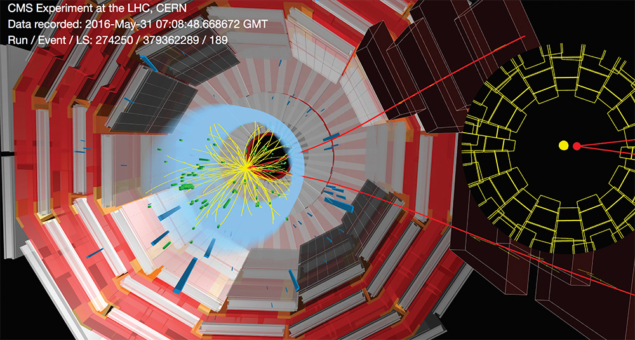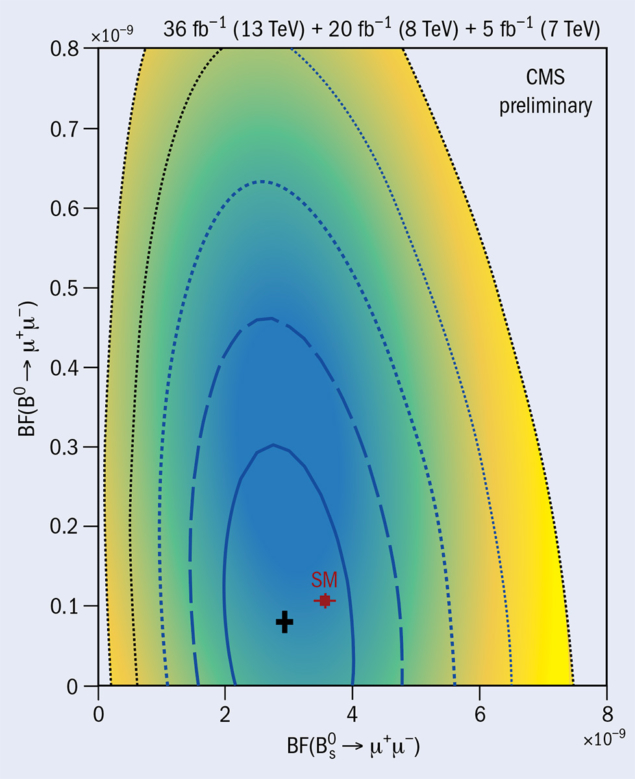A report from the CMS experiment

The Bs meson is a bound state of a strange quark and a beauty antiquark – as such it possesses both beauty and strangeness. For many years the search for its extremely rare decay to a μ+μ– pair was a holy grail of particle physics, because of its sensitivity to theories that extend the Standard Model (SM). The SM predicts the decay rate for Bs → μ+μ– to be only about 3.6 parts per billion (ppb). Its lighter cousin, the B0, which is made from a down quark and a beauty antiquark, has an even lower predicted branching fraction for decays to a μ+μ– pair of 0.1 ppb. If beyond-the-SM particles exist, however, the predictions could be modified by their presence, giving the decays sensitivity to new physics that rivals and might even exceed that of direct searches.
It took more than a quarter of a century of extensive effort to establish Bs → μ+μ–, and the first observation was presented in 2013, in a joint publication by the CMS and LHCb collaborations based on LHC Run 1 data. The same paper reported evidence for B0 → μ+μ– with a significance of three standard deviations, however, this signal has not subsequently been confirmed by CMS, LHCb or ATLAS analyses. A new CMS Run 2 analysis now looks set to bolster interest in these intriguing decays.

The CMS collaboration has updated its 2013 analysis with higher centre-of-mass-energy Run 2 data from 2016, permitting an observation of Bs → μ+μ– with a significance of 5.6 standard deviations (figure 1). The results are consistent with the latest results from ATLAS and LHCb, and while no significant deviation from the SM is observed by any of the experiments, all three decay rates are found to lie slightly below the SM prediction. The slight deficit is not significant, but the trend is intriguing because it could be related to so-called flavour anomalies recently observed by the LHCb experiment in other rare decays of B mesons (CERN Courier May/June p9). This makes the new CMS measurement even more exciting. The new analysis showed no sign of B0 → μ+μ–, and a stringent 95% confidence limit of less than 0.36 ppb was set on its rate.
CMS also managed to measure the effective lifetime of the Bs meson using the several dozen Bs → μ+μ– decay events that were observed. The interest in measuring this lifetime is that, just as for the branching fraction, new physics might alter its value from the SM expectation. This measurement yielded a lifetime of about 1.7 ps, consistent with the SM. The measured CMS value is also consistent with the only other such lifetime measurement, performed by LHCb.
With three times more Run 2 data yet to be analysed by CMS, the next update – based on the full Run 1 and Run 2 datasets – may shed more light on this fascinating corner of physics, and move us closer to the ultimate goal, which is the observation of the B0 → μ+μ– decays.
Further reading
CMS Collaboration 2019 CMS-PAS-BPH-16-004.
CMS and LHCb collaborations 2015 Nature 522 68.
LHCb Collaboration 2017 Phys. Rev. Lett. 118 191801.
ATLAS Collaboration 2019 J. High Energy Phys. 04 098.





